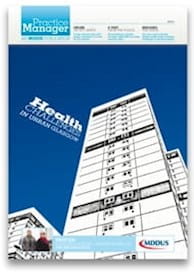A trailing cable can cause a trip and result in broken bones. A faulty door closer can lead to injured fingers. And a failure to ensure sharps are disposed of safely can result in nasty cuts and infections.
The ultimate responsibility for ensuring the health and safety of staff and the public in primary healthcare normally rests with the practice partners, but day-to-day responsibility is usually delegated to practice managers. And the task of handling yet another area requiring legal compliance can sometimes leave the average practice manager feeling overwhelmed.
High-profile media coverage of instances where children have been banned from playing conkers at school, or firemen’s poles have been outlawed, or knitting allegedly prohibited in hospital has given health and safety a poor public image. But just like healthcare, the great majority of day-to-day health and safety activity is of high quality, undertaken by competent and dedicated people and geared towards ensuring that people do not suffer where suffering can be avoided.
Despite the legal requirements, compliance can be achieved without clocking-up excessive time, money, effort and inconvenience. The first step is to recognise that risk management can and should be sensibly apportioned. The HSE says that risk management is about:
- Ensuring that workers and the public are properly protected
- Enabling innovation and learning, not stifling them
- Ensuring that those who create risks manage them responsibly and understand that failure to manage significant risks responsibly is likely to lead to robust action
- Providing overall benefit to society by balancing benefits and risks, with a focus on reducing significant risks - both those which arise more often and those with serious consequences
- Enabling individuals to understand that, as well as the right to protection, they also have to exercise responsibility.
Sensible risk management is NOT about:
- Reducing protection of people from risks that cause real harm
- Scaring people by exaggerating or publicising trivial risks
- Stopping important recreational and learning activities for individuals where the risks are managed
- creating a totally risk-free society
- generating useless paperwork mountains
There are a number of basic parameters for risk management in primary healthcare that managers can use as a guide to assessing risk in their own practice.
RISK ASSESSMENTS
The law requires risk assessments to be “suitable and sufficient”. A step-by-step process is the best way to ensure compliance. These steps are:
- Identifying the hazards
- Deciding who might be harmed and how
- Evaluating the risks and deciding on precautions
- Recording your significant findings
- Reviewing assessments and updating where necessary.
Risk assessments must be conducted by a competent person. This means someone with the necessary training, skills, experience and knowledge.
NOT JUST ACCIDENTS
The hazards people face in the workplace also include stress, physical and mental health issues and the risk of workplace violence. Options for managing stress and mental health might include setting realistic consultation times, crisis management plans for coping with emergencies and arranging external support from occupational health or counselling services.
There are many strategies to manage the potential for workplace violence. These range from ensuring cash and medications are not kept on the premises (and providing clear signage to that effect) to training personnel most at risk to be able to recognise aggressive/ threatening behaviours and to defuse potentially volatile situations. Dealing with health factors might include reasonable adjustments to work processes and/or access to an occupational physician.
SPECIFIC HAZARDS
Clinical procedures and equipment bring specific hazards into the workplace and in some cases the severity and likelihood of risk is deemed high in the absence of proper controls. Robust rules are required for such cases and there is a shared responsibility between the practice manager and the clinicians. This requires excellent communication and trust if risks are to be reduced to acceptable levels. Issues to consider include medications, hazardous substances and clinical waste.
The work environment features a wide variety of hazards and risks including fire, slippery floors, lighting, electricity, asbestos and health hazards created through increased use of display screen equipment. Again, suitable and sufficient risk assessments are required for these, the findings of which will highlight where control measures and procedures are needed.
Despite the urban myths about absurd health and safety requirements, a sensible approach to risk management will ensure risk control and reduction without unreasonable demands for time, money and other resources.
Law At Work provides a combination of sensible, practical and bespoke solutions to risk management. This article only provides a brief overview and we welcome any queries you may have about health and safety.
This article was updated on February 4, 2016
This page was correct at the time of publication. Any guidance is intended as general guidance for members only. If you are a member and need specific advice relating to your own circumstances, please contact one of our advisers.
Read more from this issue of Practice Manager

Save this article
Save this article to a list of favourite articles which members can access in their account.
Save to library

